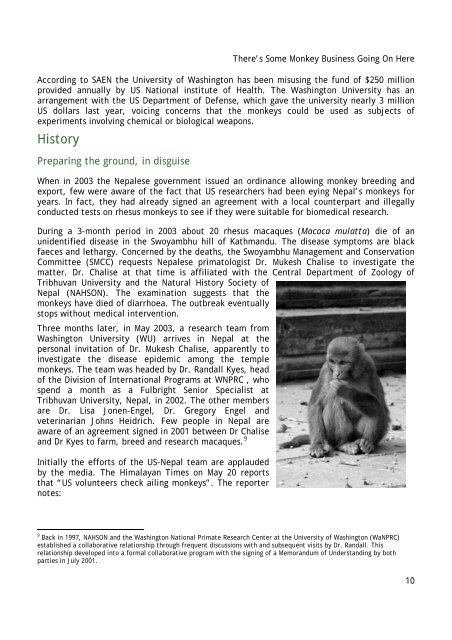Stop Monkey Business Campaign Report - Get a Free Blog
Stop Monkey Business Campaign Report - Get a Free Blog
Stop Monkey Business Campaign Report - Get a Free Blog
You also want an ePaper? Increase the reach of your titles
YUMPU automatically turns print PDFs into web optimized ePapers that Google loves.
There’s Some <strong>Monkey</strong> <strong>Business</strong> Going On Here<br />
According to SAEN the University of Washington has been misusing the fund of $250 million<br />
provided annually by US National institute of Health. The Washington University has an<br />
arrangement with the US Department of Defense, which gave the university nearly 3 million<br />
US dollars last year, voicing concerns that the monkeys could be used as subjects of<br />
experiments involving chemical or biological weapons.<br />
History<br />
Preparing the ground, in disguise<br />
When in 2003 the Nepalese government issued an ordinance allowing monkey breeding and<br />
export, few were aware of the fact that US researchers had been eying Nepal’s monkeys for<br />
years. In fact, they had already signed an agreement with a local counterpart and illegally<br />
conducted tests on rhesus monkeys to see if they were suitable for biomedical research.<br />
During a 3-month period in 2003 about 20 rhesus macaques (Macaca mulatta) die of an<br />
unidentified disease in the Swoyambhu hill of Kathmandu. The disease symptoms are black<br />
faeces and lethargy. Concerned by the deaths, the Swoyambhu Management and Conservation<br />
Committee (SMCC) requests Nepalese primatologist Dr. Mukesh Chalise to investigate the<br />
matter. Dr. Chalise at that time is affiliated with the Central Department of Zoology of<br />
Tribhuvan University and the Natural History Society of<br />
Nepal (NAHSON). The examination suggests that the<br />
monkeys have died of diarrhoea. The outbreak eventually<br />
stops without medical intervention.<br />
Three months later, in May 2003, a research team from<br />
Washington University (WU) arrives in Nepal at the<br />
personal invitation of Dr. Mukesh Chalise, apparently to<br />
investigate the disease epidemic among the temple<br />
monkeys. The team was headed by Dr. Randall Kyes, head<br />
of the Division of International Programs at WNPRC , who<br />
spend a month as a Fulbright Senior Specialist at<br />
Tribhuvan University, Nepal, in 2002. The other members<br />
are Dr. Lisa Jonen-Engel, Dr. Gregory Engel and<br />
veterinarian Johns Heidrich. Few people in Nepal are<br />
aware of an agreement signed in 2001 between Dr Chalise<br />
and Dr Kyes to farm, breed and research macaques. 9<br />
Initially the efforts of the US-Nepal team are applauded<br />
by the media. The Himalayan Times on May 20 reports<br />
that “US volunteers check ailing monkeys”. The reporter<br />
notes:<br />
9 Back in 1997, NAHSON and the Washington National Primate Research Center at the University of Washington (WaNPRC)<br />
established a collaborative relationship through frequent discussions with and subsequent visits by Dr. Randall. This<br />
relationship developed into a formal collaborative program with the signing of a Memorandum of Understanding by both<br />
parties in July 2001.<br />
10


